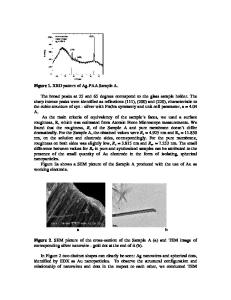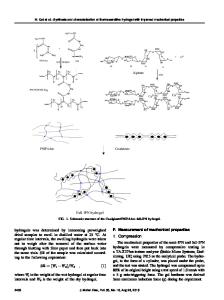Synthesis, characterization, and properties of lead-based relaxor ferroelectrics
- PDF / 457,732 Bytes
- 9 Pages / 612 x 792 pts (letter) Page_size
- 39 Downloads / 383 Views
MATERIALS RESEARCH
Welcome
Comments
Help
Synthesis, characterization, and properties of lead-based relaxor ferroelectrics Michael M. A. Sekar a),b) Department of Inorganic and Physical Chemistry, Indian Institute of Science, Bangalore 560 012, India
Arvind Halliyal Materials Research Centre, Indian Institute of Science, Bangalore 560 012, India
K. C. Patil Department of Inorganic and Physical Chemistry, Indian Institute of Science, Bangalore 560 012, India (Received 23 February 1995; accepted 17 January 1996)
Lead-based relaxor ferroelectrics such as Pb(Mg1/3 Nb2/3 )O3 (PMN), Pb(Zn1/3 Nb2/3 )O3 (PZN), and their solid solutions with BaTiO3 and PbTiO3 have been prepared by a solution combustion process which involves metal nitrates/oxalate and tetraformal trisazine (TFTA) at 350 ±C. Thermal evolution of perovskite relaxors has been investigated at different temperatures of calcination using the powder x-ray diffraction method. Particles are fine and sinter-active at low temperature (1050 ±C). Both particulate and dielectric properties are compared.
I. INTRODUCTION
II. EXPERIMENTAL
The processing of single-phase perovskite, leadbased relaxor materials is challenging. There are numerous reports on the preparation of lead-based relaxor ferroelectrics.1–4 Methods such as coprecipitation, sol-gel, microencapsulation, molten salt, and two-step columbite have been utilized for the processing of relaxors. The main problems in processing of leadbased relaxors are (i) formation of a low dielectric phase such as pyrochlore, (ii) PbO volatilization, and (iii) irreproducible dielectric properties. Among the methods reported in the literature, the columbite method is successful in stabilizing the lead-based relaxor perovskites. Swartz and Shrout5 used PbO and MgNb2 O6 as starting materials to obtain stoichiometric perovskite, Pb(Mg1/3 Nb2/3 )O3 (PMN). Lead zinc niobate, Pb(Zn1/3 Nb2/3 )O3 (PZN), is very difficult to synthesize as single-phase perovskite. However, it has been stabilized by forming a solid solution with BaTiO3 , SrTiO3 , and PbTiO3 . The present study aims at the preparation of leadbased relaxors by a combustion method that has been exploited for the preparation of titanates and zirconates.6,7 This paper describes the preparation of lead-based relaxor ferroelectrics and their solid solutions by a solution combustion process. The combustion processed powders have been characterized by powder x-ray diffraction, particle size, surface area, sintering behavior, and dielectric properties.
A. Combustion synthesis of relaxor materials
a)
Address all correspondence to this author. Presently at Chemistry Department, Bar Ilan University, Ramat Gan, Israel.
b)
1210
http://journals.cambridge.org
J. Mater. Res., Vol. 11, No. 5, May 1996
Downloaded: 12 Mar 2015
Relaxor ferroelectrics, Pb(Mg1/3 Nb2/3 )O3 (PMN), Pb(Zn1/3 Nb2/3 )O3 (PZN), and their solid solutions with BaTiO3 and PbTiO3 have been prepared by two different pathways as follows. B. Single-step method
Relaxor ferroelectrics have been prepared by comb
Data Loading...










